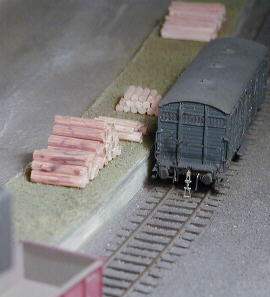 zoom
detail
zoom
detail
The new coupling for fiNe-scale is explained in this document. MFK is short for the German text MagnetFeld Kupplung, which means Magnetic Field Coupling. The name makes it clear that the normal form of operation is by applying a magnetic field. The coupling itself is a representation of the standard continental screwcoupling existing out of two etched parts. A hook with elongated hole that is fixed on the centerline of the wagon at bufferheight. The other part is the moving part and is fitted into the elongated hole of the hook before fixing the hook on the wagon. The screwcoupling part comes from a etch which consist of special selected stainless steel. The hook is etched from Nickel Silver. The parts are available from :
Schiffer Design, Herrenstrasse 13, D50170 Kerpen, Germany, tel. 02273 9592-0 or mailto:Mail@Schiffer-Design.de
The wagons on the photos used in this explanation are equiped with hooks from etch 2006 and coupling etch 2003. Both come along with 10 parts on the etch, enough to convert 5 wagons. For clarity the parts on the photo have not been treated with chemical blackening agent.
First photo shows how the blank coupling looks on a fiNe-scale
wagon. In this case a grocery van of the dutch state railways with extra
goodies in the form of a brake platform, hoses and lots of other details
that normally are forgotten by the r-t-r manufacturers. The longitidunal
hole which is used for fitting in the hook. The other side is a triangular
loop. The wider side is used to catch the hook and comes in two sizes.
This is the widest etch nr. 2003 measuring 1.3 mm inside, etch nr. 2006
measures 0.9 mm. Note that the catching of the hook becomes more difficult
on a smaller radius or with larger overhang of the wagon. The 0.9 mm is
thought for short wagons on prototypical radius of 190 m (1.2 m) or larger.
 zoom
detail
zoom
detail
The wagons are standing on Bovigny, a Fremo module depicting a wood loading dock, halfway on the line connecting Luik and Gouvy in Belgium, . The cruel enlargement even shows the tiniest dust particles. Track is code 40 from Micro Engineering, USA.
This photo shows the coupling mounted on a cattle wagon and the type of magnet used for operation hovering above it using my third hand. The magnet actually consist of a set of 7 identical magnets by courtesy of Jens, the field of this magnet is parallel to the track. Clear to see is that the coupling is raised by the magnetic field without having to touch the wagon by hand. Actually the coupling is manipulated by positioning the field. The coupling can take several positions of which this one is used to couple. The other important position is when the coupling is repelled by the magnet. This is shown on the next photo
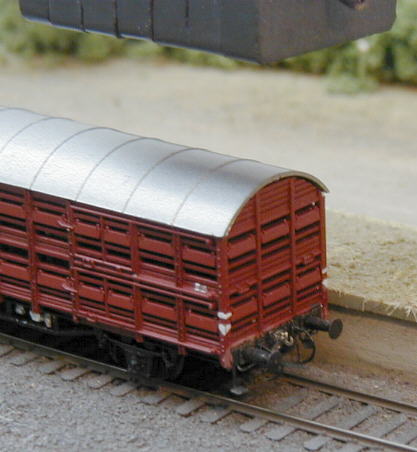
The difference is caused by the position of the magnet in relation to the coupling. In this case the magnet is above the wagon, in the raised position the magnet is moved further out over the front of the wagon to about halfway. For coupling 2 wagons practise shows that it couples easiest as the standing wagon has his coupling underslung and the moving wagon has his coupling raised. But with a little more experience the other way round is feasible too. The whole procedure is sketched with the following series of photos.
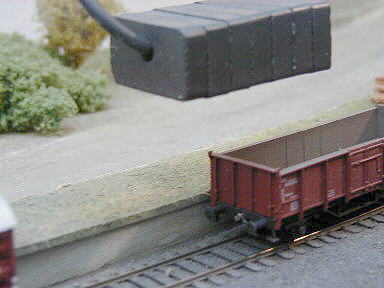
Here we see how we position the magnet above an open wagon. The magnet is about halfway over the coupling and the coupling is repelled and in underslung position. We keep the magnet in this position and then move the cattle wagon toward the open wagon.
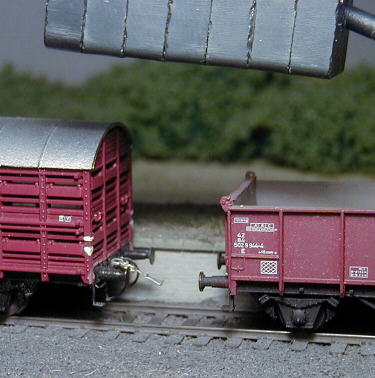
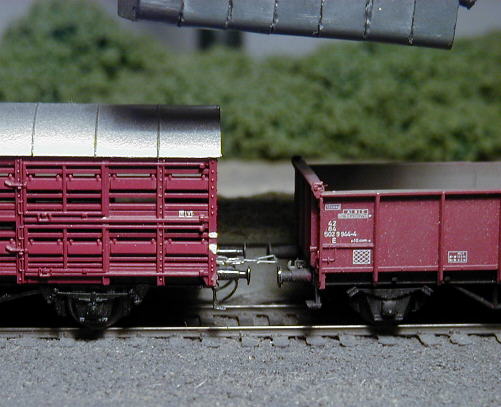
Notice that everything is magnified about 10 times the real dimensions. When we propel the cattle wagon under the magnet the coupling starts to raise, when the buffers are about 3 mm apart the coupling reaches the height of the hook.
This photo clearly shows the hook hovering above the hook. When we now raise the magnet the coupling will drop into the hook.
Here we are coupled up and can either move out or go on pushing two wagons coupled as shown in the next photo. Note that only 1 coupling of a pair is used, the one on the open wagon is hanging down. Smarties might think that they only need 1 coupling per wagon but note that screwcoupling part is bearing in the hook thus you need at least 2 hooks on either side and therefore might fit the other screwcoupling as well.
The buffers are touching as the pushing is over the buffers. The coupling is not strained and moved backwards in its elongated hole. The small indent in the hook prevents the coupling from working its way toward the top and falling out. The coupling is matched for the use with standard continental buffers of 4 mm length.
copyright text and photos by Henk Oversloot, 16 july 2000
copyright coupling design by Jens
Emmermann & Schiffer Design, 1999.